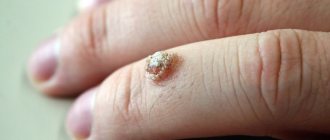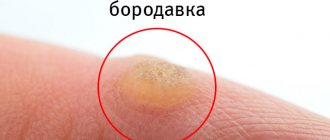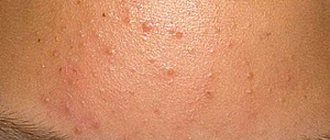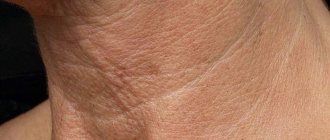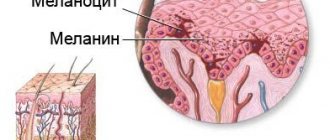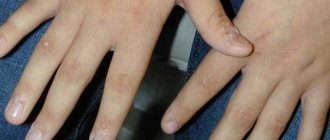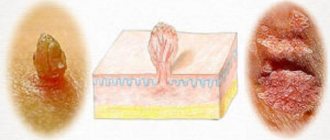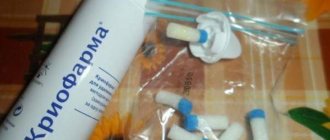A wart on the eye is one of the most unpleasant types of growths on the face. And the point is not only a sharp deterioration in the level of attractiveness of both men and women, but also a significant deterioration in the quality of life associated with the disruption of usual things. So, with a wart on the eye, you cannot normally apply cosmetics or do makeup, and if the growth has developed very strongly, then your vision may even be impaired, not to mention difficulties with the movement of the eyelid or the risk of injury to the wart. Competent treatment under the supervision of a specialist will allow you to get rid of warts on the eye, but first you need to understand the reasons for the development of the structure and stop the influence of provoking factors.
Kinds
A wart is a benign growth that appears on the skin. This is not just a cosmetic defect; its occurrence signals the presence of human papillomavirus in the body . The top layer of skin, under the influence of the virus, begins to grow rapidly, forming a growth. Neoplasms can occur anywhere in the body—on the torso, limbs, neck, and even on the face.
Warts located on the face come in different colors: from flesh-colored, colorless to white, pink, brown, black formations of uniform color or interspersed. They are painless and may not cause physical discomfort, except when they are located on moving parts of the face.
The following types of warts are distinguished:
- Ordinary - small swellings of a neutral or light brown color.
- Flat - similar in shape to a dome, can grow several in one area, quite often appear on the lower and upper eyelids.
- Thread-like - have a thin stalk, look like cauliflower inflorescences, and tend to grow to significant sizes.
Warts on the eyelids should not be confused with other formations: neuromas, nevi, melanomas, cholesterol plaques. For an accurate diagnosis and treatment, you should consult a dermatologist, and if localized on the eyelid, an ophthalmologist.
Diagnostics
There are a huge number of types of growths that appear on the eyelid. These can be melanomas, nevi, neuromas or cholesterol plaques. Before starting treatment, a person must be sure that his tumor is a wart.
In cases where the growth is located on the eyelid, it is necessary to contact not only a dermatologist, but also an ophthalmologist. Diagnosis is primarily based on a personal examination of the patient by a doctor. Additionally, biomicroscopy of the skin is performed, examination with a magnifying glass and a Wood's lamp. In rare cases, a biopsy of the affected area may be prescribed.
Causes
A person who has a wart is a carrier of the human papillomavirus. For its external signs to appear, especially with numerous growths, a cause that activates HPV is required.
Causes of warts on the eyelids:
- intense or excessive exposure to ultraviolet radiation,
- stressful conditions,
- weakening of the immune system,
- excessive sweating,
- age over 60 years,
- hypothermia,
- infectious diseases and operations,
- sudden climate changes,
- chronic overwork and fatigue.
The papilloma virus enters the body as a result of close contact with a carrier of infection. Many people, even when infected, show no external signs of the disease. This means that the virus is in an inactive, dormant state. The carrier is contagious to others, although he himself may not know about the disease . Transmission of the virus can occur during childbirth from a sick mother and due to non-compliance with personal hygiene rules. You can get HPV by using someone else's cosmetics, towels, or shoes. Once in the body, the pathogen waits for suitable conditions for activation.
Routes of transmission of the virus
Virus transmission occurs in several ways.
- In first place, breaking records, comes the sexual tract. Together with HPV, you can thus become the owner of a whole bunch of microorganisms transmitted through sexual contact - trichomonas, chlamydia, etc.
- From mother to child (scientifically, vertical path). Infection occurs when a child passes through the birth canal.
- Contact and household path. Unfortunately, even despite compliance with all sanitary and hygienic standards, it is impossible to protect public places from viruses that are highly persistent in the environment. High humidity contributes to the long-term preservation of the infectious activity of HPV. You need to remember this when visiting swimming pools, water parks, baths and saunas. Papilloma on the eye is a consequence of this transmission route.
The impetus for the activation of the virus in the body is usually stress factors, infectious diseases, hypothermia, and hormonal changes.
That is, the fact of infection does not mean that an ugly nodule will immediately appear on the face.
Treatment
One of the main principles in treatment is to do no harm. Warts on the eyelids require special attention and approach because they are located in such a sensitive area. When trying to remove the growth, it is important not to damage the eye itself.
Treatment methods:
- exposure to salicylic acid,
- freezing,
- laser removal,
- use of folk remedies.
The simplest and most popular method is cryotherapy .
This is the application of low temperature liquid nitrogen to freeze damaged tissue. After a short time, a blister appears in the treated area, which dries out and falls off after a week along with the wart growth. If the germination is large or deep, the procedure must be repeated for complete removal. If at least some of the diseased cells remain, re-growth will begin. The method is quite painful, but given the small size of the treated area, it can be tolerated without anesthesia. For children, a shorter exposure time and a larger number of procedures are used. After removal, especially in the first months, a scar may be visible. Products with salicylic acid will also help remove warts, the effect of which gradually kills the cells of the affected tissue and leads to their exfoliation. The size of the formation decreases until it disappears completely. Disadvantages include the length of the process, the risk of acid containing drugs getting into the eyes and the need to exfoliate dead tissue, which is not always convenient given the location.
The most radical and fastest way to get rid of warts on the eyes is to use a laser. The method is based on the ability of the laser device to act on the capillaries that nourish the diseased tissue. They are destroyed, and the neoplasm dies. This method has no contraindications, no age restrictions, and there are no scars or scars left at the site of removal. The disadvantage is the relatively high cost of the procedure, the recovery period and its pain.
How to get rid of warts on the eyelid?
Due to the proximity of the wart to the eye, not all treatments are approved
Many people are interested in how to get rid of warts on the eyelid. Currently, many methods are used to treat growths. Preference is given to medications and surgical removal, as an addition it is allowed to use traditional medicine.
Traditional methods
In order to remove a wart, traditional medicine is not used as the main remedy, since the results from these methods are minimal. The following folk methods are used in the treatment of warts:
- Lubricate the affected area with aloe juice. The leaf must be young - this is the only way to achieve an antibacterial effect.
- Make a paste of fresh potatoes and apply to the wart as a mask. Do it several times a day, it is recommended to leave it overnight.
- Wipe papillomas with freshly squeezed sour apple juice.
- Apply ice to the affected area, but such manipulation is allowed only for a short period of time.
- Apply the inside of a banana peel to your eyelid.
- Apply a fresh aloe leaf to the entire eyelid at night.
- Drink herbal decoction. To do this, mix lemon balm, plantain, dandelion roots and nettle. The herb is brewed, then you need to drink 50 ml daily.
Since traditional methods involve the use of natural ingredients, this increases the likelihood of allergies. To do this, before starting therapy, you need to make sure that there are no allergic reactions and begin treatment gradually.
Medications
Special medications are used to remove warts on the eye. The most commonly used oil is tea tree oil, which can be purchased at any pharmacy. This oil has antiseptic and antimicrobial properties, which allows you to quickly suppress the inflammatory process.
In addition, the following local remedies are used to treat warts:
- Viferon ointment. The product has a natural composition and is aimed at suppressing the inflammation process. To treat warts, it is used up to 5 times daily, the course of therapy is 30 days.
- Castor oil. Nourishes the skin and helps remove warts. The oil is applied only at night; it is allowed to use it until the papilloma completely disappears.
- Panavir-gel. Effectively affects the virus that causes warts. The duration of treatment should not exceed 10 days. The drug does not cause allergic reactions and is easily tolerated by patients.
- Imiquimod. The product is absolutely safe for removing warts on the eyes and has a gentle composition. Apply 3 times every day, the course of therapy is determined individually and depends on the persistence of papillomas.
It is also recommended to take the tablets orally:
- Arbidol. The course of treatment is 1 week, take 3-4 tablets daily.
- Isoprinosine. Only a doctor can prescribe the dosage; most often it does not exceed 4 tablets daily. The course of therapy should not exceed 2 weeks. After a break, treatment can be repeated.
- Immunal. The course of treatment and dosage are individual in each case.
The listed drugs do not have a direct indication for the removal of warts, but they are aimed at restoring the protective functions of the body. If your immunity is normal, then getting rid of papillomas will be much easier.
Surgical methods
After surgery, there is a high probability that a scar will remain at the site of the removed wart.
A surgical scalpel is rarely used to remove warts, since this method is the most traumatic. It involves a long recovery period and there is a risk of wound infection. This method is used only when other methods are inappropriate. Modern medicine suggests the following methods for removing papillomas:
- Chemical. This method involves applying special preparations to the affected area. You can burn off papilloma either in a medical facility or on your own. But for the latter option, a preliminary consultation with a dermatologist is necessary. It is not always possible to remove the growth the first time using a chemical method, so manipulations are carried out many times.
- Laser. Removal with a special laser can only be carried out in a hospital setting. It is one of the most effective methods, as it allows you to remove papillomas in just one session, while significantly reducing the likelihood of their further appearance. The laser removes multiple warts; for this, one procedure will also be sufficient.
- Cauterization with liquid nitrogen. This method does not require anesthesia and is easily tolerated by patients. The doctor cannot determine the depth of the effect as accurately as possible, so the likelihood of negative consequences after the procedure increases. Cryodestruction does not guarantee that papillomas will not form again.
- Electrocoagulation. The wart is removed by applying an electric shock to it. The technique is most effective for surface-type growths. The likelihood of infection with this method is completely eliminated, and side effects are extremely rare.
The method of removing warts should be determined together with a doctor after carrying out the necessary diagnostic measures. The type of removal will depend not only on the type of papilloma, but also on the general condition of the patient and concomitant diseases.
Unconventional methods
You can try to remove warts from your eyes at home.
You can get rid of growths on the eyelid using the following folk remedies:
- daily consumption of garlic,
- rubbing the wart with grated raw potatoes,
- applying an oil solution of vitamin E, aloe or Kalanchoe juice, clove oil, tea tree oil, castor oil,
- applying the inside of a banana peel, sour apple.
Regardless of the method chosen, the main thing is to prevent the product from getting into your eyes. This, in addition to discomfort, can harm your vision.
Prevention
- do not allow friction or injury to the eye;
- protect yourself from exposure to sunlight;
- use glasses when visiting the pool or in open water;
- use personal means and hygiene items;
- wash with mild cleansers after swimming in pools and open water bodies.
Preventive measures: lead a healthy lifestyle; eliminate bad habits and psychological stress; avoid trauma, solar radiation; observe the rules of hygiene, especially eyelid care; undergo regular medical examinations to monitor your health.
In order to prevent the occurrence of such a pathology, it is necessary to minimize the risk of HPV infection:
- observe the rules of hygiene;
- avoid unprotected sex;
- increase immunity, treat chronic diseases;
- to refuse from bad habits;
- eat a varied and healthy diet;
- try to master methods of psychological relief and avoid stress.
You should not let the development of papillomas take its course; at the slightest suspicion, you should seek medical help.
Prevention of the formation of papilloma on the eye, as a disease transmitted through household contact, consists primarily of observing the rules of personal hygiene.
Types of growths
When small warts appear on the eyelids, they usually appear between the eyelashes. These growths rarely grow under the eyes. All warts that form in the eye area are divided into several types:
- Pointed. These are small flesh-colored growths located on the eyelids. They do not exceed 2-3 mm in size and have a cone-shaped shape. They usually appear singly or in groups of three at most.
- Filiform warts are usually small and narrow. They are distinguished by a flesh or gray tint, and in diameter they reach 3-4 mm. The key difference from the previous type is their multiplicity (4-5 pieces each). They are often localized on the outer part of the eyelids.
- Simple warts are large in size and gray/flesh in color. They reach 10-15 mm in size, so they can interfere with vision and even deform the eyelids.
The best pharmaceutical drugs
Pharmacies offer various remedies for warts on the eyes, which help remove tumors. One of them is tea tree oil, which has antiviral and antimicrobial effects. The ether has a mild effect, so it does not damage the skin. With its help, you can remove the growth and prevent relapse.
There are also special products for removing large and small warts around the eyes and eyelids. These include Panavir gel, which does not cause irritation or allergic reactions.
This is interesting: How to remove a plantar wart from the root
Viferon ointment is a universal remedy for combating warts, including in the eye area. The antiviral drug is created on the basis of plant components, so it can be used up to five times a day.
Imiquimod is a cream with a gentle composition that does not cause discomfort even on the delicate skin near the eyes. Use the drug every other day before bed until the growths disappear.
There are also good tablets that help treat warts on the eyelids and near the eyes. Among them are Isoprinosine, Immunal and Arbidol, but it is recommended to take them only as prescribed by a doctor, who must conduct a preliminary diagnosis.
